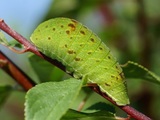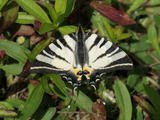
Русские, остановите эту войну! Спасите Свободную Украину!
Russians, stop this war! Save Free Ukraine!
Biodiversity Map
Taxa

Iphiclides — subordinate taxa:
Taxon count: 1
-
Arthropodaphylum
Click to switch
to select orders
and filters > -
Hexapodasubphylum
Click to switch
to select orders
and filters > -
Insectaclass
Click to switch
to select orders
and filters > -
Lepidopteraorder
Click to set
as the main taxon
and as a base
← of the left panel > -
Papilionoideasuperfamily
Click to set
as the main taxon
and as a base
← of the left panel > -
Papilionidaefamily
Click to set
as the main taxon
and as a base
← of the left panel > -
Parnassiinaesubfamily
Click to set
as the main taxon
and as a base
← of the left panel > -
Graphiinitribe
Click to set
as the main taxon
and as a base
← of the left panel > -
Iphiclidesgenus
Click to set
as the main taxon
and as a base
← of the left panel >
PL
YES
name status: valid name
BioMap ID: 1203351
taxon code: 2041
taxonomy checked: YES
protection form: partial
Polish Red Book: VU
Polish Red List: VU
Data on distribution in Poland

Statistics
- Records: 556
- Publications: 2
- Collections: 5
- Publication authors: 4
- Illustrations (iconography): lacking
- Photos (specimen/observation): 8
Taxon description
Motyl równie piękny jak paź królowej, pojawia się w jednym, a w ciepłe lata w dwu pokoleniach. Lata od V do VI, a czasem i w VIII. Motyle drugiego pokolenia są większe i różnią się od pierwszego jaśniejszą barwą odwłoka. Gąsienice żerują na tarninach, wiśniach, jarzębinach, głogu, jabłoniach, śliwach, ałyczach w VII i VIII lub, jeśli występują w dwu pokoleniach, pojawiają się w VI i VII oraz VIII i IX. Gąsienice mają narządy obronne podobnie zbudowane, jak u gąsienic pazia królowej. Na zimę przepoczwarczają się, uczepione gałęzi. Poczwarki zimujące, mało zmienne w ubarwieniu, mają barwę zeschłych liści tarniny. Poczwarki z letniego pokolenia gąsienic bywają czasem barwy zielonej. Gatunek prawnie chroniony.
[294: Iphiclides podalirius (Linnaeus 1758) – witeź żeglarz]
[294: Iphiclides podalirius (Linnaeus 1758) – witeź żeglarz]
Photos
... browse
 Iphiclides
Iphiclidespodalirius
 Iphiclides
Iphiclidespodalirius
 Iphiclides
Iphiclidespodalirius
 Iphiclides
Iphiclidespodalirius
 Iphiclides
Iphiclidespodalirius
 Iphiclides
Iphiclidespodalirius
 Iphiclides
Iphiclidespodalirius
 Iphiclides
Iphiclidespodalirius
External data sources
- Ostatnie rekordy
-
1148125
 ⊡
⊡ Papilionidae: Iphiclides podalirius, PL, Nizina Wielkopolsko-Kujawska, Pojezierze Lubuskie, Równina Torzymska, lubuskie, Słubice, 2022, leg. M. Adamski
Papilionidae: Iphiclides podalirius, PL, Nizina Wielkopolsko-Kujawska, Pojezierze Lubuskie, Równina Torzymska, lubuskie, Słubice, 2022, leg. M. Adamski -
1114829
 ⊡
⊡ Papilionidae: Iphiclides podalirius, PL, Nizina Mazowiecka, mazowieckie, Warszawa, 2019, leg. G. Tomaszewicz
Papilionidae: Iphiclides podalirius, PL, Nizina Mazowiecka, mazowieckie, Warszawa, 2019, leg. G. Tomaszewicz -
1114812
 ⊡
⊡ Papilionidae: Iphiclides podalirius, PL, Nizina Mazowiecka, mazowieckie, Warszawa, 2019, leg. S. Pietrzyk
Papilionidae: Iphiclides podalirius, PL, Nizina Mazowiecka, mazowieckie, Warszawa, 2019, leg. S. Pietrzyk -
1035349
 ⊡
⊡ Papilionidae: Iphiclides podalirius, PL, Nizina Mazowiecka, mazowieckie, Warszawa, 2018, leg. S. Pietrzyk
Papilionidae: Iphiclides podalirius, PL, Nizina Mazowiecka, mazowieckie, Warszawa, 2018, leg. S. Pietrzyk -
1035020
 ⊡
⊡ Papilionidae: Iphiclides podalirius, PL, Wyżyna Małopolska, Chęcińsko-Kielecki P.K., świętokrzyskie, Kielce, 2018, leg. M. Dziedzioch
Papilionidae: Iphiclides podalirius, PL, Wyżyna Małopolska, Chęcińsko-Kielecki P.K., świętokrzyskie, Kielce, 2018, leg. M. Dziedzioch -
1031766
 ⊡
⊡ Papilionidae: Iphiclides podalirius, PL, Nizina Mazowiecka, mazowieckie, Warszawa, 2017, leg. S. Pietrzyk
Papilionidae: Iphiclides podalirius, PL, Nizina Mazowiecka, mazowieckie, Warszawa, 2017, leg. S. Pietrzyk -
1031536
 ⊡
⊡ Papilionidae: Iphiclides podalirius, PL, Nizina Mazowiecka, mazowieckie, Warszawa, 2017, leg. S. Pietrzyk
Papilionidae: Iphiclides podalirius, PL, Nizina Mazowiecka, mazowieckie, Warszawa, 2017, leg. S. Pietrzyk -
1031534
 ⊡
⊡ Papilionidae: Iphiclides podalirius, PL, Nizina Mazowiecka, mazowieckie, Warszawa, 2017, leg. S. Pietrzyk
Papilionidae: Iphiclides podalirius, PL, Nizina Mazowiecka, mazowieckie, Warszawa, 2017, leg. S. Pietrzyk -
1028095
 ×
× Papilionidae: Iphiclides podalirius (Heintze 1990)
Papilionidae: Iphiclides podalirius (Heintze 1990) -
895173
 ×
× Papilionidae: Iphiclides podalirius, PL (Kubasik et al. 1996)
Papilionidae: Iphiclides podalirius, PL (Kubasik et al. 1996) - ... more
- Powiązane publikacje
-
Kubasik W., Rybska E., Walczak U. 1996. Uwagi o motylach dziennych (Lepidoptera, Rhopalocera) Beskidu Niskiego. Wiad. Entomol., 15(1):59 [144].
 full text
full text Show records
Show records -
Heintze J. 1990. Motyle Polski (wydanie drugie uzupełnione). Wydawnictwa Szkolne i Pedagogiczne, Warszawa. 302 pp.
 Show records
Show records
- Powiązane zbiory
-
ISEZ PAN
 Show records
Show records -
Muz. Górnośląskie, Bytom
 Show records
Show records -
Muz. Górnośląskie, Bytom: Skalski A.
 Show records
Show records -
Muz. Górnośląskie, Bytom: Skrabania S.
 Show records
Show records -
AC
 Show records
Show records
- Wykaz powiązanych pozycji
-
The Distribution Atlas of Butterflies in Poland
 Show records
Show records





